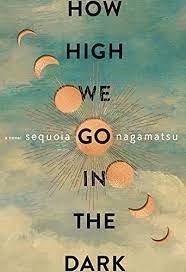How High We Go in the Dark, by Sequoia Nagamatsu
To view this as a pandemic novel is to take a too limited view of all Nagamatsu attempts here. While this series of interlocking links of stories chained together leading slowly, then quickly into the future, addresses various aspects of culture, psychological effects of grief, and generational change as a result of the loss of huge numbers of people, Nagamatsu rockets beyond even these considerations to humanity as a whole, the trajectory of our entire story. Starting from the kernel of a story, the discovery of an ancient corpse in the melting permafrost of Siberia, unleashing a long-frozen virus upon mankind, we assume the first person perspectives of a series of individuals trying to live their life in their part of the world, with their personal losses, as time marches forward and the virus takes a huge number of victims. With such great loss of life, a surviving generation is left with no family, no sense of purpose, no mentorship, unmoored from history and meaning.
Nagamatsu creates interesting cultural solutions to the twin problems of massive loss of life and rising sea waters, such as high rise towers where our deceased remains are housed; amusements parks where parents can take their dying children to enjoy their last day of life innocently; and finally, a remarkable scientific discovery leads to an interstellar expedition in search of a new planet for colonization, away from the problems of Earth. Nagamatsu ends with a tour de force, and unexpected twist to explain all of human history.
There are so many nuggets here I haven’t even touched upon, subtle turns of story that you will ponder days after reading this book; in fact, I know you will want to go back and re-read some stories to pull further meaning from them. He has packed so much into this singular volume, it is hard to imagine he will have more to say in the future. I hope he writes more surprising novels in the future, as he seems to be a gifted storyteller. Highly recommended.

